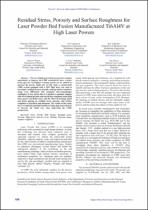 ResearchSpace
ResearchSpace
Residual stress, porosity and surface roughness for laser powder bed fusion manufactured Ti6Al4V at high laser powers
JavaScript is disabled for your browser. Some features of this site may not work without it.
- ResearchSpace
- →
- Research Publications/Outputs
- →
- Conference Publications
- →
- View Item
| dc.contributor.author |
Makoana, Nkutwane W

|
|
| dc.contributor.author |
Yadroitsava, I

|
|
| dc.contributor.author |
Yadroitsev, I

|
|
| dc.contributor.author |
Du Plessis, A

|
|
| dc.contributor.author |
Tshabalala, Lerato C

|
|
| dc.contributor.author |
Pityana, Sisa L

|
|
| dc.date.accessioned | 2023-01-17T06:58:52Z | |
| dc.date.available | 2023-01-17T06:58:52Z | |
| dc.date.issued | 2021-11 | |
| dc.identifier.citation | Makoana, N.W., Yadroitsava, I., Yadroitsev, I., Du Plessis, A., Tshabalala, L.C. & Pityana, S.L. 2021. Residual stress, porosity and surface roughness for laser powder bed fusion manufactured Ti6Al4V at high laser powers. http://hdl.handle.net/10204/12581 . | en_ZA |
| dc.identifier.isbn | 978-0-6397-0111-0 | |
| dc.identifier.uri | http://hdl.handle.net/10204/12581 | |
| dc.description.abstract | The use of high-powered lasers presents a unique opportunity to improve the LPBF productivity since a larger beam spot size and higher scanning speeds can be utilized to increase the process build rate. In this study, a custom-built LPBF system equipped with a 5kW fiber laser was used to investigate residual stresses, porosity, and top surface roughness using x-ray diffraction and computed micro-topography techniques. It was shown that it is possible to produce samples with low residual porosity and top surface roughness using high laser powers and build rates, and the effect of scanning speed and hatch spacing on residual stress, porosity, and surface roughness is presented and discussed. The results of this study have revealed the potential benefits of using high powered laser to increase the build rate, thus improving the LPBF productivity. | en_US |
| dc.format | Fulltext | en_US |
| dc.language.iso | en | en_US |
| dc.relation.uri | https://site.rapdasa.org/past-proceedings-2021/ | en_US |
| dc.relation.uri | https://site.rapdasa.org/wp-content/uploads/2022/07/2021-RAPDASA-PROCEEDINGS-ISBN-978-0-6397-0111-0.pdf | en_US |
| dc.source | 2021 RAPDASA-RobMech-PRASA) Digital Manufacturing: Industrialising Africa, International Convention Centre, CSIR, Pretoria, 3-5 November 2021 | en_US |
| dc.subject | High power Selective Laser Melting | en_US |
| dc.subject | Laser powder bed fusion | en_US |
| dc.subject | Porosity | en_US |
| dc.subject | Residual stress | en_US |
| dc.subject | Surface roughness | en_US |
| dc.subject | Titanium alloys | en_US |
| dc.title | Residual stress, porosity and surface roughness for laser powder bed fusion manufactured Ti6Al4V at high laser powers | en_US |
| dc.type | Conference Presentation | en_US |
| dc.description.pages | 136-139 | en_US |
| dc.description.note | Paper presented at the 2021 RAPDASA-RobMech-PRASA) Digital Manufacturing: Industrialising Africa, International Convention Centre, CSIR, Pretoria, 3-5 November 2021 | en_US |
| dc.description.cluster | Manufacturing | en_US |
| dc.description.impactarea | Laser Enabled Manufacturing | en_US |
| dc.identifier.apacitation | Makoana, N. W., Yadroitsava, I., Yadroitsev, I., Du Plessis, A., Tshabalala, L. C., & Pityana, S. L. (2021). Residual stress, porosity and surface roughness for laser powder bed fusion manufactured Ti6Al4V at high laser powers. http://hdl.handle.net/10204/12581 | en_ZA |
| dc.identifier.chicagocitation | Makoana, Nkutwane W, I Yadroitsava, I Yadroitsev, A Du Plessis, Lerato C Tshabalala, and Sisa L Pityana. "Residual stress, porosity and surface roughness for laser powder bed fusion manufactured Ti6Al4V at high laser powers." <i>2021 RAPDASA-RobMech-PRASA) Digital Manufacturing: Industrialising Africa, International Convention Centre, CSIR, Pretoria, 3-5 November 2021</i> (2021): http://hdl.handle.net/10204/12581 | en_ZA |
| dc.identifier.vancouvercitation | Makoana NW, Yadroitsava I, Yadroitsev I, Du Plessis A, Tshabalala LC, Pityana SL, Residual stress, porosity and surface roughness for laser powder bed fusion manufactured Ti6Al4V at high laser powers; 2021. http://hdl.handle.net/10204/12581 . | en_ZA |
| dc.identifier.ris | TY - Conference Presentation AU - Makoana, Nkutwane W AU - Yadroitsava, I AU - Yadroitsev, I AU - Du Plessis, A AU - Tshabalala, Lerato C AU - Pityana, Sisa L AB - The use of high-powered lasers presents a unique opportunity to improve the LPBF productivity since a larger beam spot size and higher scanning speeds can be utilized to increase the process build rate. In this study, a custom-built LPBF system equipped with a 5kW fiber laser was used to investigate residual stresses, porosity, and top surface roughness using x-ray diffraction and computed micro-topography techniques. It was shown that it is possible to produce samples with low residual porosity and top surface roughness using high laser powers and build rates, and the effect of scanning speed and hatch spacing on residual stress, porosity, and surface roughness is presented and discussed. The results of this study have revealed the potential benefits of using high powered laser to increase the build rate, thus improving the LPBF productivity. DA - 2021-11 DB - ResearchSpace DP - CSIR J1 - 2021 RAPDASA-RobMech-PRASA) Digital Manufacturing: Industrialising Africa, International Convention Centre, CSIR, Pretoria, 3-5 November 2021 KW - High power Selective Laser Melting KW - Laser powder bed fusion KW - Porosity KW - Residual stress KW - Surface roughness KW - Titanium alloys LK - https://researchspace.csir.co.za PY - 2021 SM - 978-0-6397-0111-0 T1 - Residual stress, porosity and surface roughness for laser powder bed fusion manufactured Ti6Al4V at high laser powers TI - Residual stress, porosity and surface roughness for laser powder bed fusion manufactured Ti6Al4V at high laser powers UR - http://hdl.handle.net/10204/12581 ER - | en_ZA |
| dc.identifier.worklist | 26369 | en_US |





